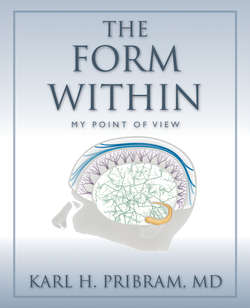Читать книгу The Form Within - Karl H Pribram - Страница 51
На сайте Литреса книга снята с продажи.
Signs of the Times
ОглавлениеAn excellent example of the strengths and limitations of currently accepted views regarding the feature detection versus the frequency views is provided by a Scientific American article (April 2007) entitled “The Movies in Our Eyes,” authored by Frank Werblin and Botond Roska. The article describes a series of elegant experiments performed by the authors, who recorded the electrical activity of ganglion cells of the retina of rabbits. It is the ganglion cells that give rise to the axons that relay to the brain the patterns developed during retinal processing of radiant energy. The authors had first classified the ganglion cells into 12 categories depending on their receptive fields, their dendritic connections to earlier retinal processing stages. These connections were demonstrated by injecting a yellow dye that rapidly spread back through all of the dendrites of the individual ganglion cell under investigation.
21. Orientation tuning of a cat simple cell to a grating (squares and solid lines) and to checkerboards of various length/width ratios. In A the responses are plotted as a function of the edge orientation; in B as a function of the orientation of the Fourier fundamental of each pattern. It can be seen that the Fourier fundamental but not the edge orientation specifies the cell’s orientation tuning (From K. K. DeValois et al., 1979. Reprinted with permission.)
The authors recorded the patterns of signals generated in each of the different types of ganglion cell by a luminous square and also by the presentation of a frame of one of the author’s illuminated faces. They then took the resulting patterns and programmed them into an artificial neural network where they were combined by superposition. The resulting simulation was briefly (for a few milliseconds) displayed as an example of a retinal process, a frame of a movie, sent to the brain. In sequence, the movies showed a somewhat fuzzy depiction of the experimenter’s face and how it changed as the experimenter talked for a minute.
In their interpretation, the experimenters emphasized the spatial aspect of the representation of the face and the time taken to sequence the movies. They also emphasize the finding that the retina does a good deal of preprocessing before it sends a series of partial representations of the photic input to the brain for interpretation: “It could be that the movies serve simply as elementary clues, a kind of scaffolding upon which the brain imposes constructs” (p. 74). Further: “ . . . the paper thin neural tissue at the back of the eye is already parsing the visual world into a dozen discrete components. These components travel, intact and separately, to distinct visual brain regions—some conscious, some not. The challenge to neuroscience now is to understand how the brain interprets these packets of information to generate a magnificent, seamless view of reality” (p. 79).
However, the authors ignore a mother lode of evidence in their own findings. The electrical activity, both excitatory and inhibitory, that they record from the ganglion cells, even from the presentation of a square, show up as wavelets! This is not surprising since the input to the ganglion cells is essentially devoid of nerve impulses, being mediated only by way of the fine-fiber neuro-nodal web of the prior stages of processing—a fact that is not mentioned in the Scientific American paper. Wavelets are constrained spectral representations. Commonly, in quantum physics, in communication theory and in neuroscience the constraint is formed in space-time. Thus, we have Gabor’s quanta of information.
Werblin and Roska speak of “packets of information” but do not specify whether these are packets of scientifically defined (Shannon) information or a more loosely formulated concept. They assume that the space-time “master movie” produced by the retinal process “is what the brain receives.” But this cannot be the whole story because a considerable amount of evidence has shown that cutting all but any 2% of the optic nerve does not disturb an animal’s response to a visual stimulus. There is no way that such an ordinary master movie could be contained as such in just 2% of any portion of the optic tract and simply repeated in the other 98%. Some sort of compression and replication has to be involved.
Given these observations on Werblin and Roska’s experimental results and the limitations of their interpretations, their presentation can serve as a major contribution to the spectral view of visual processing as well as the authors’ own interpretation in terms of a feature view. The spectral aspect of their data that they ignore is what is needed to fill out their feature scaffolding to form what they require to compose the seamless view of the world we navigate.
22. The Retinal Response to a Rectangle
23. Activity of a Second Ganglion Cell Type
